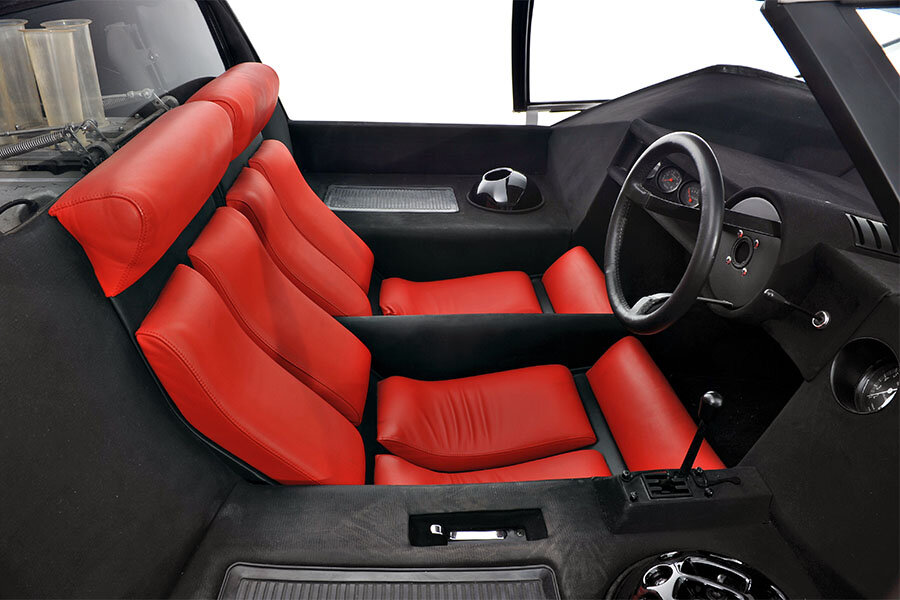Guide: Ferrari Pininfarina Modulo - a Historical & Technical Appraisal
/BACKGROUND
Just four months after Pininfarina had displayed the outlandish 512 S Speciale, the wraps came off their most extreme Ferrari styling concept yet.
Known as Modulo, it became Pininfarina’s defining creation of the 1965 to 1970 era.
During this time, Pininfarina were supplied with a variety of Ferrari and Alfa Romeo sports racing chassis. These low slung state-of-the-art platforms were used to produce a series of cutting edge designs.
Although the firm had a reputation as more conservative than rival some of their high profile domestic rivals, for sheer influence, the radical Modulo ranked alongside luminaries such as the Maserati Boomerang (Ital Design) and the Alfa Romeo Carabo, Lancia Zero and Lamborghini Countach (all of which were designed by Bertone).
With its pure wedge profile and other worldly aura, the Modulo became one of Pininfarina’s most famous 20th century design concepts. However, it was the last time the firm would create a show car on a surplus Ferrari sports racing chassis as all subsequent cars were sold off to privateer teams and collectors.
This inevitably led to a major reduction in the number Pininfarina-Ferrari dream cars; after producing eight during a flurry of activity between 1965 and 1970, the next 20 years yielded just three: the 1974 Cr 25, the 1980 Pinin and the 1989 Mythos.
The Modulo was built on chassis 0864. It broke cover at the Geneva Motor Show in March 1970.
CHASSIS
Chassis 0864 started life as the first Ferrari 612 Can-Am and had previously been used for mock up work on the 512 S (during which time it was re-numbered 512 S 27).
The chassis itself was a tubular steel semi-monocoque with aluminium panels riveted in place for extra rigidity. It had a 2450mm wheelbase and fuel tanks mounted in each sill.
Suspension was via unequal length wishbones, coil springs and telescopic shocks plus anti-roll bars at either end.
The outboard ventilated brake discs were supplied by Girling and the five-spoke star-pattern wheels by Campagnolo.
ENGINE
Although actually still equipped with its original 6.2-litre 612 Can-Am engine block, for promotional purposes, the Modulo was quoted as running a five-litre motor from the recently introduced 512 S.
Power for both the 612 Can-Am and 512 S came from 60° V12 engines that shared the same block, crankcase and sump.
Dual overhead camshafts, dry-sump lubrication, four-valve cylinder heads and Lucas high-pressure fuel-injection were standard fare on both power units.
Ignition was via an electronic Marelli Dinoplex system with a single spark plug for each cylinder.
Thanks to a bore and stroke of 87mm and 70mm respectively, displacement of the 512 motor supposedly installed in the Modulo was 4993cc.
With a compression ratio of 11.5:1, the 512 S had a peak output of 550bhp at 8000rpm.
BODYWORK
The Modulo’s spectacular bodywork was created to explore future styling trends and practically zero attention was paid to real world usability.
The new car was impossibly low, extremely wide and although it had a considerable glass area, proved very difficult to see out of.
Aside from its overall profile, the Modulo’s most notable feature was a radical opening canopy that slid forwards thanks to cockpit pylons that ran along slim gulleys located on the front fenders.
Huge side windows were fixed in place. A retractable engine cooling scoop was located behind them.
A black insert on each sill mirrored the combined window / intake profile.
At the front, retractable headlights had three square lenses per side and clear covers. Underneath, NACA ducts that fed cool air to the brakes were carved out from each corner of the front apron.
A red swage line wrapped around the body and was used to discretely house indicators at both ends.
At the rear, the swage line was interrupted by a rectangular aperture from which four square exhausts emerged.
Like many design studios, Pininfarina commonly made styling features out of cooling solutions. To allow hot air out from the engine bay, the fastback rear screen featured two vertical banks of circular cooling holes.
However, most startling was the arrangement for brake cooling - as all four wheels were enclosed, the upper body sections were cut away to expose the top of each tyre.
Pininfarina originally painted the Modulo black with white inserts and red swage line.
INTERIOR
Inside, rather than fit conventional seats, six separate cushions were mounted on a steeply raked backboard each side. The seats were upholstered in red vinyl and sunk between the wide sills and tall central divider.
The sills, rear bulkhead, seat backboards, transmission tunnel and door panels were all trimmed in white vinyl.
As the windows were fixed in place, cockpit temperature had to be adjusted via huge domed ventilation outlets located on each sill.
A futuristic leather rimmed steering wheel featured three projecting spokes. So limited was space from above, the instrumentation had to be located off to each side.
Like all Ferrari's V12-engined sports racing cars of the period, the Modulo was right-hand drive with a corresponding right-hand gearchange.
SUBSEQUENT HISTORY
After starring at the Geneva Motor Show in March 1970, Pininfarina reversed the Modulo's exterior colour scheme from black to white and later switched the interior from red to black.
The car was shown around the world over the next couple of years and won a host of international design awards.
Text copyright: Supercar Nostalgia
Photo copyright: Ferrari - https://www.ferrari.com






































